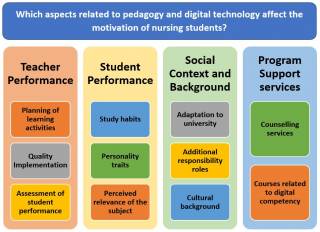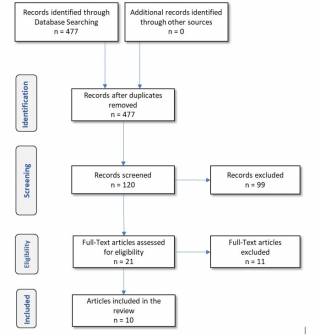Introduction
Given the stressful nature of the nursing discipline, and the critical role that motivation plays in the performance of nursing students during their undergraduate studies, we considered that the development and implementation of good teaching practices by educational and administrative staff, related to the subject of motivation is of critical importance. Parallel to this, and even prior to the COVID pandemic, competent use of digital education technology, paired with the design and practice of effective and evidence-based pedagogical methods have become a core theme of modern educational practice.
Within that context, our research question was: Which aspects related to pedagogy and digital technology affect the motivation of nursing students?
Results
The literature review was conducted using EBSCO academic metasearch service. The accessed Databases were BMC Nursing, PubMed, Gale Academic, SAGE Knowledge, and Emerald Insight. The time frame for selecting articles was between 2015 and 2021. Search criteria included key words related to nursing students, information technology (and similar terms), motivation, engagement, and pedagogy (and related terms). The inclusion criteria were articles about objectives related to motivation of nursing students, the context of the articles had to be related to some use of information technology and teaching methodology or pedagogy and articles were not literature reviews. Total of 10 articles were selected to literature review after screening of titles, abstracts and full text read (Appendix 1).
As a result, we identified four main categories that should be considered by educators and nursing program coordinators, to foster and maintain the motivation of nursing students, especially during their first years. These categories are Teaching performance, Student Performance, Social Context and Background of the student and Program Support Services.
The category of Teaching Performance relates to the how much individual teachers apply a series of skills and practices in their day-to-day activities, and how these activities are perceived by the students. For example, planning of learning activities has to do with how their structure and contents are interactive, organized, and attractive. That is, planning that the choice of technological resources and how they correspond to a teaching methodology and are appropriate to the contents of the learning subjects. Quality implementation is how these planning activities are in fact implemented during courses and are accompanied with timely feedback and valuable methods for assessing students’ performance.
The second category is Student performance which describes how students view their own performance, and how in fact this performance reflects their learning outcomes and goals, and also, influences their motivation. Aspects such as effective study habits (e.g., organized study environment, time management as well as whatever inherent personality traits (e.g., maturity, introversion or extroversion, social aptitude) are closely related and relevant to the degree of motivation. Also, we identified that the degree of how the student perceives the subject being studied as relevant to their profession, affects their level of engagement during courses. Related to the previous category, the element of relevance could be controlled by the planning and performance of the teacher.
The category three identified Social Context and background of nursing students. The sociocultural background influences students’ level of motivation, for example when beliefs and knowledge of the students themselves are considered while producing educational materials, they give greater meaning to these and achieve in-depth learning. Also, social aspects such as adaptation to university life, especially during the first bachelor year, is affecting students’ level of motivation (e.g., tutoring by other students from higher semesters was shown to help them adjust better). And finally, any additional responsibility roles that nursing students have within their family (such as providing economic support to their families) can affect their physical and emotional capacity to tackle the academic workload and thus, influence their experienced degree of motivation.
The Program support services forms the fourth category. This is perceived as an effective operation at institutional or faculty level such as tutoring or counseling services within the nursing program (e.g., university induction and adaptation courses, counseling for lagging or irregular students, study skills courses, etc.). The existence of these services has effect on the perception of accompaniment of the student at institutional level, and thus on their motivation. Within this context, when the nursing program has available curricular or extracurricular courses (e.g., nursing practices that are relevant to their professional choice where the student identifies in combination with) related to learning digital and information search and management skills it also influences positively on students’ motivation.

Conclusions
The categories of teachers’ and students’ performance could be seen as evident or self-explanatory in the subject of students’ motivation but the categories of social context and background as well as program support services might not usually be considered as subjects affecting the nursing student’s motivation. These categories could present an area of opportunity for modern curriculum designs and for the implementation or refinement of even more modern institutional services. Moreover, they could be relevant for teaching and administrative staff of Latin American nursing programs to strengthen students’ motivation.
Findings, especially the category of students’ performance, concur with studies related to the construction of self-efficacy which in turn, is fundamental to motivation and academic performance.
References
[1] M. L. Bartlett, H. Taylor, and J. D. Nelson, “Comparison of mental health characteristics and stress between baccalaureate nursing students and non-nursing students,” J. Nurs. Educ., vol. 55, no. 2, pp. 87–90, 2016, doi: 10.3928/01484834-20160114-05.
[2] M. Willis-Shattuck, P. Bidwell, S. Thomas, L. Wyness, D. Blaauw, and P. Ditlopo, “Motivation and retention of health workers in developing countries: A systematic review,” BMC Health Serv. Res., vol. 8, pp. 1–8, 2008, doi: 10.1186/1472-6963-8-247.
[3] K. Mäenpää, H. Järvenoja, J. Peltonen, and K. Pyhältö, “Nursing students’ motivation regulation strategies in blended learning: A qualitative study,” Nurs. Heal. Sci., vol. 22, no. 3, pp. 602–611, 2020, doi: 10.1111/nhs.12702.
[4] S. K. Y. Chow and J. L. K. Wong, “Supporting academic self-efficacy, academic motivation, and information literacy for students in tertiary institutions,” Educ. Sci., vol. 10, no. 12, pp. 1–13, 2020, doi: 10.3390/educsci10120361.
[5] T. J. A. Busebaia and B. John, “Can flipped classroom enhance class engagement and academic performance among undergraduate pediatric nursing students? A mixed-methods study,” Res. Pract. Technol. Enhanc. Learn., vol. 15, no. 1, pp. 1–16, 2020, doi: 10.1186/s41039-020-0124-1.
[6] M. Tower, R. Walker, K. Wilson, B. Watson, and G. Tronoff, “Engaging, supporting and retaining academic at-risk students in a Bachelor of Nursing: Setting risk markers, interventions and outcomes,” Int. J. First Year High. Educ., vol. 6, no. 1, pp. 121–134, 2015, doi: 10.5204/intjfyhe.v6i1.251.
[7] Y. J. Choi, “Undergraduate Students’ Experiences of an Integrated Psychiatric Nursing Curriculum in Korea,” Issues Ment. Health Nurs., vol. 37, no. 8, pp. 596–601, 2016, doi: 10.3109/01612840.2016.1172142.
[8] C. Phillips and J. O’flaherty, “Evaluating nursing students’ engagement in an online course using flipped virtual classrooms,” Student Success, vol. 10, no. 1, pp. 59–71, 2019, doi: 10.5204/ssj.v10i1.1098.
[9] C. Haraldseid, F. Friberg, and K. Aase, “How can students contribute? A qualitative study of active student involvement in development of technological learning material for clinical skills training,” BMC Nurs., vol. 15, no. 1, pp. 1–11, 2016, doi: 10.1186/s12912-016-0125-y.
[10] J. J. Lee, C. L. Clarke, M. N. Carson, and S. C. Yang, “How do Korean nursing students build knowledge? A constructivist grounded theory study,” BMJ Open, vol. 8, no. 7, pp. 1–10, 2018, doi: 10.1136/bmjopen-2018-022050.
[11] L. L. Hsu, H. C. Hsiang, Y. H. Tseng, S. Y. Huang, and S. I. Hsieh, “Nursing students’ experiences of using a smart phone application for a physical assessment course: A qualitative study,” Japan J. Nurs. Sci., vol. 16, no. 2, pp. 115–124, 2019, doi: 10.1111/jjns.12215.
[12] L. M. A. De Oliveira, E. M. De Souza, E. F. Pontes, L. L. Pereira, M. R. Apostolico, and A. C. Puggina, “Motivação De Alunos De Enfermagem No Uso Das Tecnologias Da Informação E Comunicação,” Rev. Baiana Enfermagem, vol. 31, no. 3, pp. 1–13, 2017, doi: 10.18471/rbe.v31i3.17898.
Appendix 1. Prisma Search strategy


Comments